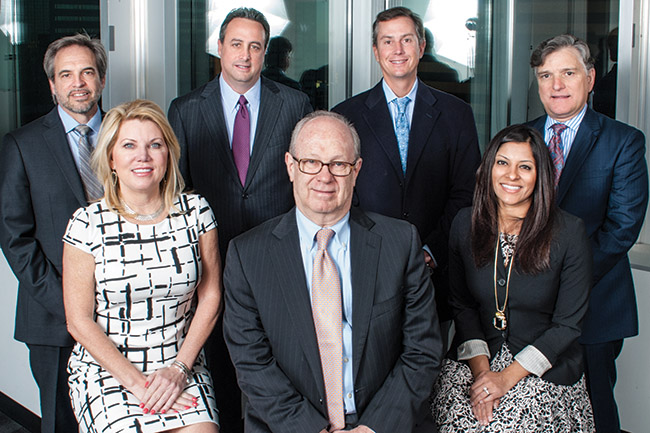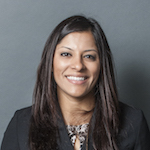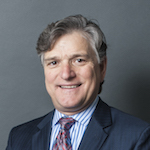
After decades of urban planning that focused on segregating property types, mixed-use is emerging as the hottest development trend in North Texas. It wasn’t too long ago that “New Urbanism” was considered a fad, with most developers taking the traditional route and building standalone office, retail and multifamily projects.
But Corporate America and millennials are demanding the live-work-play experience. That powerful force has sparked a flurry of massive new mixed-use developments across Dallas-Fort Worth, including CityLine in Richardson, Cypress Waters near Coppell, Legacy West in Plano, and The Star in Frisco, among others. Along with that, the market is seeing a number of vertical mixed-use redevelopment projects, such as the Statler Hilton and One Main Place in downtown Dallas.
What are some must-haves—and some common mistakes—in mixed-use development? What are lender perspectives on the product type? And how much mixed-use can the market support? We asked seven industry experts to weigh in on these and other topics. Participating in the roundtable discussion were Randy Cooper of DTZ, Robert Dozier of Lincoln Property Co., Mick Granlund of O’brien Architects, Arti Harchekar of Townscape, Marijke Lantz of Billingsley Co., Frank Mihalopoulos of Corinth Properties, and Neal Sleeper of Cityplace Co. Here’s what they had to say.

Q: How have mixed-use projects evolved over the years, and what’s behind the explosive growth in development?
RANDY COOPER: In the 1980s, there would be a piece of land, and it would show retail on the front, very dense and urban-like, with office space, and then apartments or multifamily in the back. But so few of those developments really ever got built around here. In the 1990s, we would use the term “mixed-use” for an office building that had a deli and some really bad retail around the corner, with apartments that were unconnected but just happened to be there. Then, because you had such broad, geographic areas between the different submarkets, developers became inward focused on their buildings, and what a tenant’s experience would be like. What’s happening lately is driven by the maturity of the tenant base, on what they’re looking for, especially as they start to see successful projects around the country.
MARIJKE LANTZ: It used to be just dealing with tenants who are there from 9 a.m. to 5 p.m. Maybe they’d have a beer afterwards. Maybe they could drive down the street and get the dry cleaning. Today, mixed-use is not just for the employees that work in the office buildings, but residents, too. Can they, during the day, go out and do some sort of sports or outdoor activity, and then go back to the office?
Can they get out and clear their heads? This means having restaurants, office space, outdoor amenity space, multifamily, and a place for people to walk their dogs.
COOPER: There’s also the need for having well-thought-out plans for automobile traffic and pedestrian traffic. Thinking about what it means, psychologically, to walk through a landscaped, well-thought-out plaza that is in and amongst the mixed-use development, versus something that has cars whizzing by.
ROBERT DOZIER: At Lincoln, mixed-use early on was an afterthought as to certain components. Our apartment group would say we want some ground-floor retail. We’d drop a Subway, a dry-cleaners, and a coffee store and call it mixed-use. The evolution in mixed-use that we’ve seen at Lincoln is a greater integration of all of the components—office and retail and multifamily—without one component being added just as an afterthought to the original development. From the retailer’s perspective, the evolution has really come from condensing their footprint and agreeing to go more urban and do things that they wouldn’t typically do in the past. They talked a mean game early on. When the retailers said they wanted to do something urban, that meant they still wanted their 40,000-square-foot footprint and their sea of parking out front. Now we’re seeing retailers that are coming around, wanting to create that unique, different experience that helps drive sales. Getting people out for an experience, as opposed to online shopping.

ARTI HARCHEKAR: It’s the nuances when we craft these urban areas. They need to be walkable in the sense that you can walk and get to your daily services within five minutes. But also, paying attention to streets that are multimodal and that act as linear civic spaces and are also functional. Environments that are actually stimulating, where people want to be,and you have this creative flow of ideas. That’s really what makes these successful places. Then having trails, open spaces, a vibrant mix of uses and a high-quality building fabric that actually interfaces with the street. Where the programming of the public realm works with what’s going on in the buildings.
NEAL SLEEPER: The highest form is when you create a walkable environment—the ability to live someplace where you can shop, maybe go to your office, do most of the things you do on a regular basis, without ever having to get in your car. It really takes a well-thought-out, critical mass of retail, so that the retailers actually feed off of each other. To have the kind of streetscape where people really can feel safe and enjoy, with wide, well-lit sidewalks, and interesting things to walk by, as opposed to a parking lot.
COOPER: In a mixed-use development, there needs to be a shared mindset. So when a developer that owns a tract of land starts talking with a retail specialist, a multifamily specialist, and an office specialist, they really need to be in sync. The developer needs to listen to all those experts. There are so many large-scale developments going on in Dallas right now, in different parts of the city. The mindset of an office user of a million-square-foot campus with 4,000 people in a building is that they want to be in mixed-use development, but if they keep their own people inside the building with a company cafeteria—or worse, a subsidized company cafeteria— expect the retail to fail. They’re going to just die during the day.
FRANK MIHALOPOULOUS: The real key is traffic generators. A project can be employment-based, like State Farm and CityLine, or it’s star-based like the Dallas Cowboys’ project in Frisco. Mass-transit is another traffic generator. It’s service-based, be it a job or health center. Traffic is the fuel that feeds mixed-use. If you don’t have traffic, you’re not going to succeed. Many mixed-use projects have had issues. Many have lost money. Mockingbird Station lost $20 million before the second owner took it over. And yet we look at that as one of the most successful mixed-use projects today. And if it wasn’t for the public subsidizing projects with TIFs, or Plano writing a check to get Toyota there, it doesn’t work. First, you’ve got to create a need.

The other part is evolution. I’m Greek. The Greeks invented most of everything that you see today. If y’all remember, the original mixed-use project was the Acropolis. Underneath the parking lot is the Plaka, and underneath is the shopping district. So for everybody who has been to Greece, you see mixed-use at its best there.
My forefathers—the Parthenon, the Acropolis, all the gods that created the use, created the traffic generator. People lived there, people ate there, people shopped there. It survived thousands of years, because it was built on a mountain, on a certain area. The urban cities of Chicago, New York, and Washington—they’re all based on an urban plan to be a mixed-use community. These were evolutions of the streets, the sidewalks. You go to Barcelona. They don’t have 90-degree corners. They have 45-degree angles on their buildings so they can open a plaza into the intersection so people have interaction going on. Part is the planning and how you interact, but it’s how you lay the foundation.
LANTZ: Corporations used to be so inward-focused. They wanted the employees to get to the office and stay there. They go to work, have the cafeteria, and then they leave. Now businesses are realizing that people want to come and go during the day, and they sometimes will be more productive at 10 p.m., because they went out and did their event outside somewhere andthen came back. So now the corporations are starting to rethink their needs by being outwardly-focused, based on their employees. And remember, you’ve got three generations in these office buildings.
COOPER: They’re battling for new employees, and those new employees don’t want to eat in the company cafeteria. That’s not their idea of fun.
MICK GRANLUND: There are a couple of things really driving the popularity of mixed-use developments right now. First, a lot of cities are looking around and trying to figure out ways to bring people back into the city by providing a mixed-use development that has living, working, dining. It encourages people to come back into the inner core.

Second, it has to do with our younger people and how they live and spend their money. Fundamentally, I don’t think young people today are that much different, because we all want to spend time with our friends. When I was a young person, my vehicle for doing that was my car. Today, the vehicle is your cell phone. Then prior to young people starting their family, you have to get to your job. You have to have a place to live.
Your expendable income is either spent out in the suburb, supporting an apartment or a house, a car, couple of cars maybe, or it’s spent in one of these mixed-use, urban areas where they don’t have to have two cars—or a car at all. They can have more disposable income to spend communicating with their friends, either at a restaurant nearby or whatever. Those things are driving people more towards mixed-use development.
COOPER: This is not a hypothesis: When you talk to the HR directors at these companies, they will explain to you what type of environment they’re looking for. It’s because of direct interaction with employees that are dictating exactly what it is. They’re not doing it because they think it might be cool; they’re doing it because they know that they need to be in the lead with respect to who they’re going to hire and what their proposed hiring plan would be. Millennial employees have to be happy. If they’re not happy, they’re not going to be productive. It’s different for my generation. Nobody ever told me I’ve got to be happy. However, in order for millennials to thrive, and in order for the company to thrive, there’s a certain level of happiness that has to be a part of their work environment, and mixed-use delivers on that.
HARCHEKAR: One other force is the housing market. Millennials are postponing when they’re going to have children, and then you have baby boomers that are downsizing. Hence, more than 80 percent of the growth in households is going to be families without children. They want to be in urban environments, where they have stimulation and social interaction with people outside in the community.
Q: So let’s break down demand for mixed-use space from office user, retail tenant, multifamily resident, developer, and investor perspectives.

LANTZ: It’s funny, because we’re all talking urban, but really the definition of “urban” has changed to suburban-urban, as it’s out in Frisco and Plano, and it’s Cypress Waters and all those different places. Whoever would have thought that when we’re talking about urban mixed-use, we would be talking about Richardson or Far North Dallas, where 10 years ago there was really nothing there. The whole definition of “urban” really has changed, just because of the mixed-use environments.
HARCHEKAR: We’ve been hearing a lot about Class A offices and the need for true integration. However, there’s also a growing need for an incubator office. Single-owner businesses are on the rise. As baby boomers retire they want to continue their income, and need their own places to work. Therefore, these flexible, mixed-use environments are important in terms of having a collaborative environment, with a continuous flow of ideas. Cooperative space, street-facing live/work, live/work lofts—all of these things are going to be as important as Class A offices.
COOPER: The No. 1 engine for all this is the continued population and job growth. Without that, there wouldn’t be the fuel to go develop these huge mixed-use developments. This is another big advantage of North Texas. It is a huge geographic area. In almost every direction, there’s growth. There are still huge chunks of available land with an incredible development community here—some of the folks sitting here at this table—that have capability to go pull these things off, with the financial sources they need and the expertise. A lot of cities are much further along in their maturity and just don’t have the opportunity we have. They have available land outside of their communities, but we have that plus so much population and job growth. Think about it: We have five or six huge new mixed-use developments on a scale that never existed before. It’s unbelievable.

SLEEPER: From an office standpoint, Uptown is a great example. People are moving to Uptown because it’s what their employees want. They want that walkable environment. They want the ability to live near where they work. They want to be able to have a lot of choices for places to eat, places to shop, places to go after work for a drink. All of that plays into what has made Uptown successful.
Twenty or 25 years ago, all the real estate companies were moving out north of LBJ. Now they’re all moving Uptown and downtown. People are competing for employees, and that millennial generation and even some older employees really want to be in this kind of environment. That was a big factor in The Richards Group moving closer in. Their employees wanted to be in the Uptown environment.
MIHALOPOULOS: In the suburbs, where a lot of these big projects are kicking off, it’s driven by the employer. It’s driven by State Farm. It’s driven by Toyota. It’s driven by FedEx Office. They wanted an urban style of life, not a campus style. The problem we have, though, is retail is not the driving force. The retail guys—we follow housing, and job centers, and we’re supplementing the services. At the Toyota headquarters, the retail will be 70 percent restaurants. Never has it been that much. It used to be 30 percent restaurants and the opposite retail shops, specialty. So everything is confined to more of a service, part of the entertainment. … Now, you have cities forcing apartment developers to put in percentage retail. For example, we need to put 14,000 square feet in a project on Fort Worth Avenue with Trammell Crow Residential. We’ve designed the retail next to it, but the key here is, it’s part of the project, but it’s separated.
SLEEPER: Frank, you bring up a good point. I heard a term at a UIL panel the other day about “de-retailing.” De-retailing is where cities required somebody to build retail at the base of their apartment complex, and you can’t get anybody to lease it; or if you do, it’s the bail bondsman or the pawn shop and the nail salon. So they’re going back in and converting that space to something else, because it really does not work in a retail model. Another interesting thing is your point about the 70 percent restaurants in these places. The thing that’s getting harder and harder is creating an environment where those so goods retailers can be successful, and doing that in a mixed-use environment. You guys have done it, Robert, but what’s the key to that? How do you make that work?
DOZIER:Well, it’s funny. Our office and our multifamily divisions always say retail is important. They put the highest land cost on my component. What’s driving a lot of the mixed-use is the lifestyle choices. These are renters by choice. The retailers’ anchors today are restaurant driven and the interactive retailers are important. These are the retailers that offer an experience, whether it’s Apple doing the Genius Bar or Sur La Table doing the cooking classes, or Orvis doing fly-fishing classes. Those are unique experiences that bring customers. You want people coming back to these environments, to people watch and to walk. This is their social entertainment.

From a retail perspective, online shopping is big. So what can we do as a developer to create the experiences you can’t achieve online or in a traditional shopping center? We spend a lot of time on merchandising plans and going after the right tenants, and a lot of times you have to subsidize retailers to come in and help create that sense of place.
GRANLUND: In the past, the retail has been the driver to bring in the office and the residential around it. Now the retail is an amenity.
HARCHEKAR: Some of the things that we’ve done to alleviate the retail issue, because that’s definitely a lesson learned, is require flex space, especially in writing the ordinance for that area. Essentially, the ground floor is built to commercial standard. You have the right volume with the ceiling heights and finish-out, but any use can occupy that space until the market is ready to handle the retail. That’s one of the tools that we’ve used.
MIHALOPOULOS: The traditional retailer will not be in a mixed-use project. They could be adjacent to it or next to it. But your grocery store needs their parking. Your shoe store needs their parking. They demand their parking. If we don’t have a parking ratio of 4.5 or 5 or some cases 6 per 1,000, the deal doesn’t get done. The traditional users are going to be part of a project on more of a horizontal basis than a vertical basis. You see it in an urban area, where you’ve got an urban specialty grocery store that’s part of a project. In the suburbs, you’re still going to have to have the parking fields.
SLEEPER: It is working though, in that what we’re seeing now, in areas like Uptown, where even the grocery stores are coming in and being a part of mixed-use projects. We have a Whole Foods coming on McKinney Avenue. In the suburbs, I think it would be pretty tough to do.
Click here to read the rest of the discussion, originally published in the Spring 2015 edition of the Dallas-Fort Worth Real Estate Review, quarterly magazines produced in collaboration between D Magazine Partners, The Real Estate Council, and the Dallas Regional Chamber.





